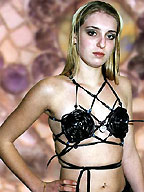Tuesday 27 July, 2010, 17:20 - Radio Randomness
Posted by Administrator
Posted by Administrator
 Last summer, here at Wireless Waffle, we came up with a design for an increadible piece of beach-wear for the short-wave listener which we cristened the 'Wireless Waffle Super Signal Holiday HF Antenna Apparel'. Not only has this become the must have item for improving reception whilst soaking up the sun, devotees have coined the nickname, 'SuSi' and it's an idea that has clearly caught on. At the end of our revelation of this unbelievable breakthrough in summer attire last year, we asked you to submit your own photos of the 'SuSi' which we would then share with other Wireless Waffle readers. And submit them you did! Here we present the 2010 SuSi Snapshot Selection. Together with the original device, it is enthralling to see so many variants in use, however we have our doubts about how effective some of the modified versions might be - so together with your photos, we have also included our view on how well the device pictured might perform.
Last summer, here at Wireless Waffle, we came up with a design for an increadible piece of beach-wear for the short-wave listener which we cristened the 'Wireless Waffle Super Signal Holiday HF Antenna Apparel'. Not only has this become the must have item for improving reception whilst soaking up the sun, devotees have coined the nickname, 'SuSi' and it's an idea that has clearly caught on. At the end of our revelation of this unbelievable breakthrough in summer attire last year, we asked you to submit your own photos of the 'SuSi' which we would then share with other Wireless Waffle readers. And submit them you did! Here we present the 2010 SuSi Snapshot Selection. Together with the original device, it is enthralling to see so many variants in use, however we have our doubts about how effective some of the modified versions might be - so together with your photos, we have also included our view on how well the device pictured might perform. This first picture was sent in by Jim Thrisby of Humberside and was taken in his laboratory with the device under test conditions, rather than out in the field. The unit in question has been modified to include a double, side-mounted dipole which will imbue it with some directionality. The use of an interconnecting cross-bar, however, will act as a short-circuit at higher frequencies and may limit the broadband functionality of the device. The inclusion of three distinct connection pads does, however, offer the wearer some flexibility in adopting the best position for reception whilst allowing the interconnecting wires not to get in the way.
This first picture was sent in by Jim Thrisby of Humberside and was taken in his laboratory with the device under test conditions, rather than out in the field. The unit in question has been modified to include a double, side-mounted dipole which will imbue it with some directionality. The use of an interconnecting cross-bar, however, will act as a short-circuit at higher frequencies and may limit the broadband functionality of the device. The inclusion of three distinct connection pads does, however, offer the wearer some flexibility in adopting the best position for reception whilst allowing the interconnecting wires not to get in the way. This next image came from Tyrone Mulligan from South Carolina and shows a similar variant to that sent in by Jim. In this case, however, the horizontal interconnecting cross-bar is missing and its omission should ensure a wider frequency response. The three interconnection pads are also present, however the triangular (instead of square) shape and blue paint used to make them 'look pretty' may introduce a high impedance into the connection which is undesirable. The use of a conductive gel or paint will ensure a more solid contact. The modified SuSi is shown in use under good conditions and is clearly being well received by the wearer.
This next image came from Tyrone Mulligan from South Carolina and shows a similar variant to that sent in by Jim. In this case, however, the horizontal interconnecting cross-bar is missing and its omission should ensure a wider frequency response. The three interconnection pads are also present, however the triangular (instead of square) shape and blue paint used to make them 'look pretty' may introduce a high impedance into the connection which is undesirable. The use of a conductive gel or paint will ensure a more solid contact. The modified SuSi is shown in use under good conditions and is clearly being well received by the wearer. Tuning of a SuSi should not require any user intervention, however some experimenters such as Dave Brookes of Sydney, Australia, have suggested that some manual adjustment to the position of the various connecting wires can improve the clarity of reception. His photo shows a relatively standard SuSi but in which the support structure has been angled so as to increase the capture of incoming waves. Dave tells us that by using the device in this way, it is possible to receive many more short-waves and even some medium and long waves, but that effectiveness was reduced as it was too easy to get 'Chile' (or that's what we think Dave said).
Tuning of a SuSi should not require any user intervention, however some experimenters such as Dave Brookes of Sydney, Australia, have suggested that some manual adjustment to the position of the various connecting wires can improve the clarity of reception. His photo shows a relatively standard SuSi but in which the support structure has been angled so as to increase the capture of incoming waves. Dave tells us that by using the device in this way, it is possible to receive many more short-waves and even some medium and long waves, but that effectiveness was reduced as it was too easy to get 'Chile' (or that's what we think Dave said). This photo, which arrived by e-mail from Harman Tallow of Newquay, Cornwall, is apparently an attempt to use some Cornish witchcraft to improve the device's effectiveness. Whilst there addition of the two 'tuning coils' may improve the reception in some directions they also act to obscure significant amounts of the underlying support structure and may even weigh it down to produce a highly undesirable 'sag' in performance at some wavelengths. According to Harman, the field trials were relatively successful in that it was easier to mount the device on the support structure compared to the original design, but that overall, the reception was disappointing.
This photo, which arrived by e-mail from Harman Tallow of Newquay, Cornwall, is apparently an attempt to use some Cornish witchcraft to improve the device's effectiveness. Whilst there addition of the two 'tuning coils' may improve the reception in some directions they also act to obscure significant amounts of the underlying support structure and may even weigh it down to produce a highly undesirable 'sag' in performance at some wavelengths. According to Harman, the field trials were relatively successful in that it was easier to mount the device on the support structure compared to the original design, but that overall, the reception was disappointing. We were particularly impressed by the efforts of Damian Hextonwick. Damian doesn't tell us where he's from but does indicate that using multiple devices in the form of a 'phased array' produces one of the largest increases in the achievable range of the device that he has witnessed (though we once again note the erroneous use of the bandwidth restricting horizontal cross-strut). His attempt to join four such devices together as shown in his picture, produced sufficient voltage to excite receivers which were at a significant distance from the array. Whereas it is necessary to connect directly to a single device to get its benefits, standing in close proximity to multiple interconnected devices has impressive results.
We were particularly impressed by the efforts of Damian Hextonwick. Damian doesn't tell us where he's from but does indicate that using multiple devices in the form of a 'phased array' produces one of the largest increases in the achievable range of the device that he has witnessed (though we once again note the erroneous use of the bandwidth restricting horizontal cross-strut). His attempt to join four such devices together as shown in his picture, produced sufficient voltage to excite receivers which were at a significant distance from the array. Whereas it is necessary to connect directly to a single device to get its benefits, standing in close proximity to multiple interconnected devices has impressive results. Finally, Heinz Wiedemann of North Germany has attempted to take the concept of the SuSi one step further and produce a device which can be used for satellites. By expanding upon the concept of a mesh dish, he has produced this mesh SuSi which has an integral 'low navel block' (LNB) at its lowest point which focuses incoming signals. Unfortunately, the alignment proves very critical and without careful hands-on positining of the LNB, the supporting structure becomes badly distorted leading to highly unsatisfactory reception. Heinz does add, however, that the hands-on nature of this variant of the SuSi has many distinct benefits which he then refuses to scientifically quantify, rendering the results of his experiments somewhat suspect.
Finally, Heinz Wiedemann of North Germany has attempted to take the concept of the SuSi one step further and produce a device which can be used for satellites. By expanding upon the concept of a mesh dish, he has produced this mesh SuSi which has an integral 'low navel block' (LNB) at its lowest point which focuses incoming signals. Unfortunately, the alignment proves very critical and without careful hands-on positining of the LNB, the supporting structure becomes badly distorted leading to highly unsatisfactory reception. Heinz does add, however, that the hands-on nature of this variant of the SuSi has many distinct benefits which he then refuses to scientifically quantify, rendering the results of his experiments somewhat suspect.Overall, we have been highly impressed by the look, feel and ingenuity of the various models of SuSi that have been submitted to us. Please keep up the experiments and remember to send pictures your results to us. We can't wait to see what the next year of experimentation may bring and to share the joyous fruits of your labours and to enjoy the summer sunshine wherever you may be.
1 comment
( 3511 views )
| permalink
| 



 ( 3 / 44669 )
( 3 / 44669 )




 ( 3 / 44669 )
( 3 / 44669 )

